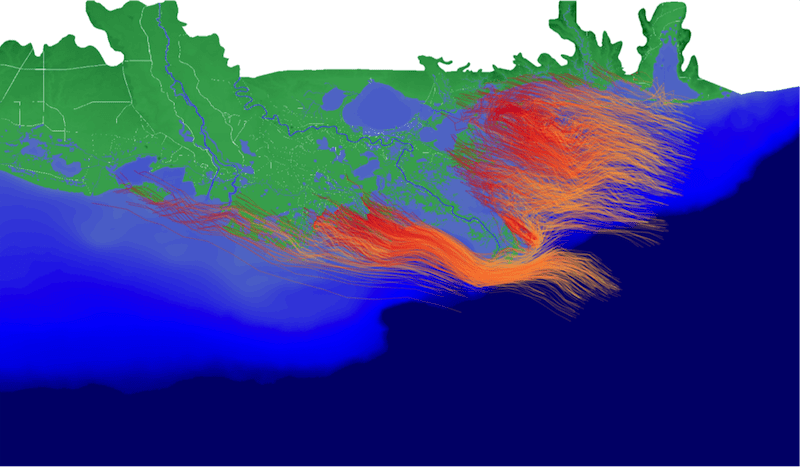Oil Spill and Dispersion Animation and Analysis
Li Yu, Aidong Lu, and William Ribarsky
Charlotte Visualization Center, UNC Charlotte
For downloadable content including data and software
please contact Dr. Xiaoyu Wang

Abstract
The storm surge tools show the correlations of several attributes of the surge in 3D across time, in both interactive visualization and automatic animation modes. The terrain change tool permits segmentation of coastal terrain with respect to dune structures, vegetation patterns, built environment such as roads, bridges, and houses and other features. We developed a method for structuring the temporal characteristics and thus understanding a large collection of storm surge animations.
This will be especially useful in the oil spill/storm surge modeling, where ensembles of simulations must be run under different storm conditions to understand the range of possibilities for oil spill spread. Unlike the tools existing in the field, our tool enables intelligent region, time range, and feature selections, which save scientists many repetitive routine operations. In the storm surge, hurricane analysis, and dynamic terrain analysis work our tools also integrate feature enhancements and automatic feature identification and tracking approaches to provide advanced domain-related analysis functions. This feature identification and tracking coupled with our data processing pipeline provides a comprehensive almanac of terrain changes over large time ranges and areas. One can thus identify both long time and short time trends in coastal terrain and infrastructure and can follow features of interest, determining when their changes will affect storm surge, coastal flooding, built infrastructure stress, emergency response, or other models of interest in coastal disaster mitigation and response. These capabilities are unique and quite powerful.
Indeed, we have lately developed an event structuring approach for complex, 4D simulations and observations that permit us to construct “stories” as the variety of phenomena we are studying unfold in time. These stories can be grouped and compared and can even be represented in the form of compact timeline signatures. This will give great power to our methods as we begin attacking ensembles of, for example, hurricane simulations where hundreds or more hurricanes must be studied together. As even more complex, coupled phenomena (e.g., coupled storm and social models) are generated, this meaningful event-based story structure will be even more necessary in providing understandable, useful results.
Video and Images
Part 1
Part 2: